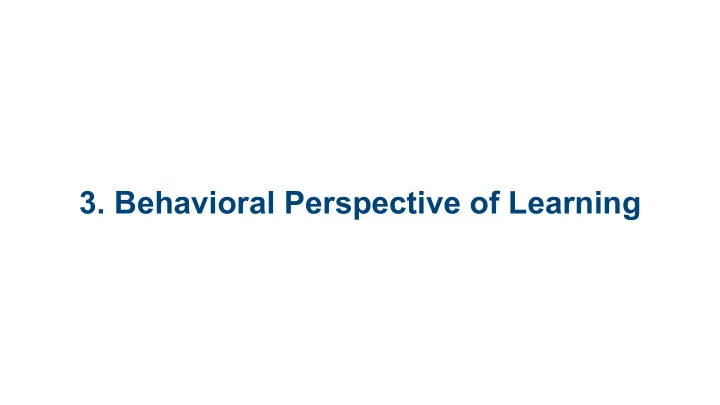

3. Behavioral Perspective of Learning
Behavior: Big Questions • Is learning just a change of behavior? • Can learning happen without intent? • Can new behavior be shaped by manipulating the environment?
3.1 Classical Conditioning 3.2 Operant Conditioning 3.3 Practical Applications of Behavioral Psychology
3.4 Cognitive Learning Theory 3.5 Summary
3.1 Classical Conditioning
Pavlov: Stimulus and Response 1 • Seeing food, dog salivates [Unconditioned Stimulus ➔ Unconditioned Response] • Ring a bell when food comes • Now bell causes salivation! [Conditioned Stimulus ➔ Conditioned Response] • Similar bell ➔ salivation due to stimulus generalization
Pavlov: Stimulus and Response 2 Limited practical application of Pavlov’s findings • For overcoming phobias • Associate stimulus with pleasant response • For overcoming obsession • Associate stimulus with unpleasant response
3.2 Operant Conditioning
Thorndike: Trial and error and its effects • Organisms use trial and error to solve problem • If effect of behavior is pleasant, organism will repeat behavior • Might repeat even when behavior no longer works!
Watson: Shaping new feelings • Albert neutral about rat • Unpleasant sound when rat is near • Now Albert is afraid of rat (emotional conditioning) • Now Albert is afraid of anything white and furry! (overgeneralized response)
Skinner: Reinforcing by increments • Want dog to dance • Reward dog (food) for every approximation of desired behavior • Later reward only for closer approximations • Now dog “dances” on cue
Types of reinforcers • Positive = something desired • Negative = remove undesired thing • Punishment = something undesired • Primary = essential to life • Secondary = symbol or currency for reward
Types of reinforcement • Continuous reinforcement ➔ subject expects reward for every performance • Until behavior is automatic • Intermittent reinforcement ➔ random and decreasing rewards • Usually gets better/faster results than continuous
When to reinforce • Fixed ratio = reinforce every n th time • Variable ratio = reinforce at no set number of times • Fixed interval = reinforce after a set amount of time • Variable interval = reinforce at no set amount of time
Punishment categories • Positive = adding or issuing something unpleasant • Negative = removing something pleasant • Meant to be a scientific procedure, without emotion!
3.3 Practical Applications of Behavioral Psychology
For extinguishing undesired behavior • Ignoring = not reacting to incorrect behavior • Time out (and other removal punishments) = taking away social contact, privileges • Corporal punishment = physical pain ➔ Meant to be a scientific procedure, without emotion!
For promoting desired behavior • Premack principle = get thing you want by doing thing you don’t like • Shaping = reinforcing partial or approximate correct behavior • Meant to be a scientific procedure, without emotion!
Other behavior modification strategies • Contingency contract with reward incentives • Token economy with reward objects to be redeemed • With or without potential for reward removal • Individual or group incentives and rewards
What about praising? “I like the way Jack is sitting quietly.” “I like the way Jill did her project neatly and correctly.” • Ripple Effect can get students to work/behave better to earn same reward • Can backfire if students feel they can’t meet expectations ➔ give up trying
3.4 Cognitive Learning Theory
Cognitive learning theory • Hybrid of behaviorism and cognitive theory • Learner observant of others, not acted upon • Learning by observing behavior and consequences (peers, adults, etc.)
Bandura: Vicarious learning • Combination of behavior, environment, and attitude • Direct modeling: adults and peers in environment • Symbolic modeling: movies, celebrities, TV, ads, etc.
Vicarious learning effects • Self-regulation by learning from observation • Self-motivation and self- reinforcement to study and emulate model • Mastery of emulation ➔ self-efficacy about abilities • Helps future performance goals for self
Vicarious learning errors • Misperception of model or environment • Acting on incomplete information • Faulty information processing (physiological or learned) ➔ Inaccurate expectations and self-assessment
3.5 Summary
Learning through direct or indirect shaping • Behaviorism: shaping behavior by association or by consequences • Cognitive learning: shaping behavior by observation of models ➔ Emphasis on learning by shaping behavior vs. conscious processing
Recommend
More recommend